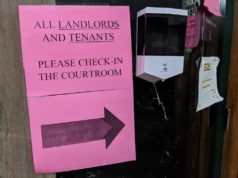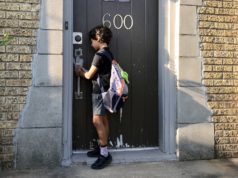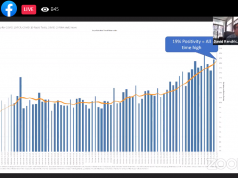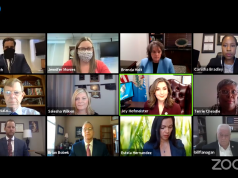
The Oklahoma Advisory Committee to the U.S. Commission on Civil Rights has published a study examining the civil rights impact of school discipline and juvenile-justice policies.
The study explains how excessive and disparate suspensions of students “may lead to high rates of juvenile incarceration” — particularly among youth of color, boys and students with disabilities — in what has become known as the school-to-prison pipeline.
In its report released this month, the committee issued a number of commonsense recommendations ranging from better professional development of teachers, of school law enforcement officers and of juvenile-justice workers to a repudiation of “zero-tolerance” disciplinary policies.
The committee recommended that the department “impose mandatory reforms to disciplinary policies for schools that demonstrate significant disparities in disciplinary actions on the basis of race, color, or disability,” but that’s not as ominous as it might seem.
I emailed Melissa Wojnaroski, civil rights analyst with the commission, for clarification.
“The U.S. DOE in collaboration with the U.S. DOJ has already issued ‘best practice’ guidance for reducing disparities in school discipline on the basis of race, color, sex and disability,” Wojnaroski wrote in her reply. “The recommendation is to make some of these reforms mandatory (rather than discretionary) for schools that continually show significant disparities in discipline on the basis of these protected categories.”
Report emphasizes multiple, subtle factors
I am not worried about these mandatory reforms because I witnessed the balance and discretion that was demonstrated during the fact-finding process.
I’ll have to admit that, in September 2015, I had been leery about testifying before the federal investigation into disparate suspensions in Oklahoma. Nothing is harder to discuss than the ways in which poverty, implicit bias and school policies interact to damage poor children of color. Moreover, we are 15 years into the data-driven school-reform movement, which is based on the idea that racial- and economic-achievement gaps are largely caused by the “benign racism of low expectations,” and that the solution is to hold individual educators accountable for meeting discrete, quantifiable targets.
I was pleasantly surprised, however, by the complete lack of political correctness during the hearing. I’m even more impressed by the way its final report, Civil Rights and the School-to-Prison Pipeline in Oklahoma, emphasized the subtle ways that multiple factors interact and disproportionately affect children of color.
Poverty as a compounding factor
The committee notes that white students are disciplined more frequently for “objective behaviors such as smoking and graffiti,” while black students are “more often punished for objective behaviors such as class disruption or dress code violations.” Those are the type of discrete patterns that must be considered within the context of “implicit bias,” or unconsciously prejudging others.
Consequently, the report says:
Black children are often perceived as older and more dangerous than their white peers. Subsequently, black students may not be afforded the same understanding from teachers, administrators, or juvenile justice workers that their white peers are.
In Oklahoma, the committee notes, “about 15 percent of African American and 7.3 percent of Latino students are disciplined with out-of-school suspension, compared to 4.7 percent for white students.”
This pattern is partially explained by economic inequities, because:
“… children in poverty may experience delays in cognitive development due to high-stress situations created by poverty such as lack of food, shelter, or stability. This can subsequently lead to delays in academic performance or acting out in class.”
And, sure enough, “Black and Latino families have a poverty rate that is twice as high as non-Hispanic white families.”
Segregation continues
Of course, it is more complicated than just poverty. The report explains how “studies show that even middle-income black families tend to live in low-income neighborhoods where residents have fewer resources than typical low-income white families.” In other words, we must acknowledge the elephant in the room: segregation.
The last time I had access to the full OKCPS data sets, about 80 percent of the district’s suspensions came from 11 neighborhood secondary schools. Those schools disproportionately serve the 13 Census tracts characterized by “extreme poverty.” In a million-person-plus metropolitan area with tens of thousands of secondary students, only about 8,000 were unable to exercise their choice and were thus left behind in these schools that tend to serve our relatively few neighborhoods that have exceptional numbers of homeless families, foster children, incarcerated parents and low levels of social capital and relational trust.
Poverty hinders childhood brain development
But it is even more complicated than poverty and economic segregation. Research documenting poverty and student behavior shows:
Poor students who live in poverty are often under great environmental stress at home and consequently do not receive the support necessary to develop at the same rate as other peers.
The committee’s report quotes Terry Smith, from the Oklahoma Institute for Child Advocacy, who testified, “It actually affects your brain development, and it starts early with these kids.”
Smith further explained the role of adverse childhood experiences (ACEs) and how they become even more destructive when large percentages of children in a school have survived multiple ACEs. The committee’s report adds:
Several research studies Smith referred to illustrate such impacts. An article in Pediatric Prevention states: “The harms of poverty are much more than a matter of unidimensional material and financial shortage but, instead, are an encompassing and unremitting experience of disadvantage, trauma, and disease.
This point is especially crucial because “Oklahoma ties with Montana for percent of children who have three or more adverse childhood experiences.” (emphasis mine)
Shared responsibility for school-to-prison pipeline
The committee’s report also addresses other factors that don’t excuse educators but should remind us that we, as an entire community, must share responsibility for the excessive and disparate suspensions that fuel the prison pipeline.
School administrators operate under the constraints of chronic underfunding of neighborhood schools, not to mention alternative schools and other support services. Similarly, if fatigued educators, “must quickly address the behavior of a student while under time constraints and ambiguous information, he or she may utilize a punishment that is based on implicit attitudes.”
Moreover, administrators and teachers agree that high-stakes testing increases class disruptions by undermining engaging and meaningful instruction.
So, I hope it is clear that neither our schools nor our individual educators can duck our own institutional and personal responsibility for our unconscionable suspension rates and how they provide a pipeline to prison.
The demonization of specific villains, whether they are “bad” teachers with “low expectations” or administrators who don’t demand that each adult in the building does “whatever it takes” to overcome our legacies of poverty and discrimination, is simplistic and counter-productive. Fixing our high-poverty schools is a major part of the “21st-century civil rights movement,” but it will take a team effort to overcome intertwined and historically determined evils.
The Oklahoma Advisory Committee’s work is a much needed step in that direction.
Full Report from the Oklahoma Advisory Committee
